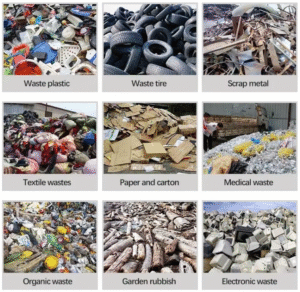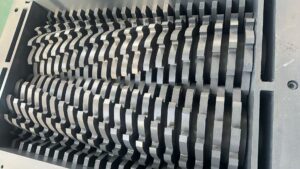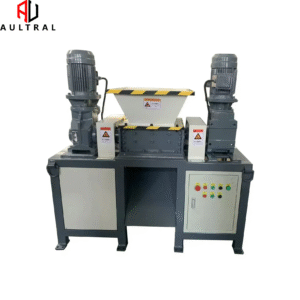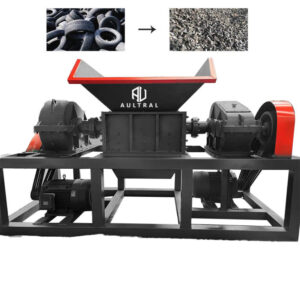Introduction
Industrial shredders are powerful machines designed to reduce the size of various materials through cutting, tearing, and crushing. They play a critical role in recycling, waste management, manufacturing, and data security by processing materials like paper, plastic, metal, wood, and even electronic waste.
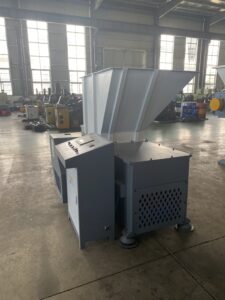
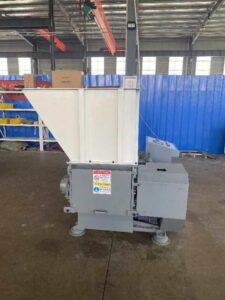
This guide explores:
-
Types of Industrial Shredders
-
Key Applications Across Industries
-
Benefits of Using Shredders
-
How to Choose the Right Shredder
-
Maintenance and Safety Tips
1. Types of Industrial Shredders
Shredders vary in design and function depending on the material they process. Here are the most common types:
A. Single-Shaft Shredders
-
Design: Single rotating shaft with blades or hooks.
-
Best for: Bulky materials like plastic, rubber, wood, and light metals.
-
Advantages: High torque, handles irregularly shaped objects.
B. Dual-Shaft Shredders (Shear Shredders)
-
Design: Two counter-rotating shafts with interlocking blades.
-
Best for: Tough materials like metals, e-waste, and industrial waste.
-
Advantages: Slower but more powerful, reduces wear and tear.
C. Granulators
-
Design: Small, high-speed rotating blades for fine shredding.
-
Best for: Plastic pellets, thin metals, and homogeneous materials.
-
Advantages: Produces uniform output for recycling.
D. Paper Shredders
-
Design: Strip-cut or cross-cut blades for confidential documents.
-
Best for: Offices, banks, government agencies.
-
Security Levels: P-1 (basic) to P-7 (military-grade).
E. Tire Shredders
-
Design: Heavy-duty blades with high torque.
-
Best for: Recycling used tires into rubber mulch or fuel.
-
Output: Steel wires removed, rubber crumb produced.
F. Wood Shredders (Chippers)
-
Design: Drum or disc-based cutting systems.
-
Best for: Landscaping, biomass energy, pallet recycling.
-
Output: Wood chips for mulch or fuel.
2. Key Applications of Shredders
A. Recycling Industry
-
Plastic Recycling: Reduces bottles, containers, and films into flakes.
-
Metal Recycling: Crushes aluminum cans, steel scraps for smelting.
-
E-Waste Processing: Separates metals from circuit boards safely.
B. Waste Management
-
Municipal Solid Waste (MSW): Shreds household trash before landfill or incineration.
-
Medical Waste: Safely destroys contaminated materials.
C. Manufacturing & Production
-
Post-Industrial Waste: Recycles defective products or excess materials.
-
Confidential Document Destruction: Ensures compliance with data privacy laws (e.g., GDPR, HIPAA).
D. Energy & Biomass
-
Tire-Derived Fuel (TDF): Shredded tires replace coal in cement kilns.
-
Wood Biomass: Shredded wood used in pellet mills for renewable energy.
3. Benefits of Using Industrial Shredders
A. Cost Savings
-
Reduces waste volume, lowering transportation and disposal costs.
-
Recycled materials can be resold (e.g., metal scraps, rubber crumbs).
B. Environmental Protection
-
Promotes circular economy by enabling material reuse.
-
Prevents hazardous waste (e.g., batteries, chemicals) from polluting landfills.
C. Enhanced Security
-
Data Shredders: Prevent identity theft by destroying hard drives/USBs.
-
IP Protection: Safeguards proprietary designs in manufacturing.
D. Operational Efficiency
-
Automates waste processing, reducing manual labor.
-
Customizable output sizes for downstream processing.
4. How to Choose the Right Shredder
A. Material Type & Volume
-
Soft materials (paper, plastic) → Single-shaft or granulators.
-
Hard materials (metal, tires) → Dual-shaft or tire shredders.
B. Output Size Requirements
-
Coarse shredding (100–300mm) for landfill reduction.
-
Fine shredding (<10mm) for recycling or biomass.
C. Power & Throughput Capacity
-
Small-scale: 5–50 HP electric motors.
-
Large-scale: 100+ HP or hydraulic systems.
D. Safety & Compliance
-
OSHA/CE-certified machines for worker protection.
-
Dust suppression systems for airborne particles.
E. Budget & ROI
-
New vs. used equipment trade-offs.
-
Energy consumption vs. long-term savings.
5. Maintenance & Safety Tips
A. Routine Maintenance
-
Blade Sharpening: Dull blades reduce efficiency.
-
Lubrication: Prevents overheating of moving parts.
-
Inspect Belts/Bearings: Avoid unexpected breakdowns.
B. Safety Measures
-
Emergency Stop Buttons: Critical for operator safety.
-
Lockout/Tagout (LOTO): Ensures machines are powered down during maintenance.
-
PPE: Gloves, goggles, and ear protection for workers.
Conclusion
Industrial shredders are indispensable for businesses aiming to improve sustainability, security, and operational efficiency. Whether you need to recycle plastics, destroy sensitive data, or process tires, selecting the right shredder depends on material type, output goals, and budget.

